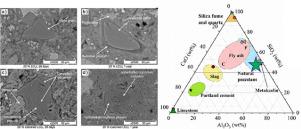Resources, Conservation and Recycling ( IF 11.2 ) Pub Date : 2021-04-01 , DOI: 10.1016/j.resconrec.2021.105584 Victor Brial , Hang Tran , Luca Sorelli , David Conciatori , Claudiane M. Ouellet-Plamondon

|
Aluminum Spent Pot lining (SPL) is an industrial hazardous waste generated from aluminum electrolysis cells. The SPL separates in two parts, the first cut is rich in carbonaceous materials and the second cut is rich in vitrified refractory. Treating second cut SPL by the Low Caustic Leaching and Liming (LCL&L) process generates an inert non-hazardous residue, called LCLL Ash. This product is mainly composed of stable crystalline phases such as corundum, albite, nepheline with some amount graphite. Ground as a fine powder, LCLL Ash could be used in cement as a supplementary cementitious material (SCM). This paper focuses on the investigation of LCLL Ash reactivity and its improvement by calcination at 1050°C. Reactivity was evaluated with multiple tests, such as compressive strength activity index, Frattini test and Rilem R3 tests followed by XRD analysis. An inert SCMs (limestone, filler, and quartz) and reactive SCMs (slag, fly ash, silica fume) were used as references. The results show that LCLL Ash in cement shows inert properties similar to quartz with a retarder effect below 7 days and a high alkali content. Moreover, the temperature of the Rilem R3 tests, shows expansion in the paste due to LCLL Ash hydro reactivity. This expansion was not observed with LCLL Ash blended cement mortar. Calcination improved significantly the reactivity of LCLL Ash by generating higher reactive silica and alumina content. Notably, calcined LCLL Ash showed reaction properties similar to a calcined clay. Finally, neither delay on hydration nor expansion was observed with calcined LCLL Ash.
中文翻译:

评估作为水泥材料的原铝生产中处理过的废锅衬里的反应性
铝废锅衬里(SPL)是铝电解槽产生的工业有害废物。SPL分为两部分,第一部分富含碳质材料,第二部分富含玻璃质耐火材料。通过低苛性浸出和石灰化(LCL&L)工艺处理二次切割SPL会产生惰性无害残留物,称为LCLL灰。该产品主要由稳定的结晶相组成,例如刚玉,钠长石,霞石和少量的石墨。LCLL Ash以细粉磨碎,可在水泥中用作辅助胶结材料(SCM)。本文着重研究LCLL灰分反应性及其在1050°C下煅烧的反应性。反应性通过多种测试进行评估,例如抗压强度活性指数,Frattini测试和Rilem R3个测试后进行XRD分析。惰性SCM(石灰石,填料和石英)和反应性SCM(矿渣,粉煤灰,硅粉)用作参考。结果表明,水泥中的LCLL灰分显示出与石英相似的惰性特性,在7天以下的阻滞效果和高碱含量。此外,Rilem R 3测试的温度显示出由于LCLL灰分的水反应性而导致的糊剂膨胀。用LCLL Ash混合水泥砂浆未观察到这种膨胀。煅烧通过产生更高的反应性二氧化硅和氧化铝含量而显着改善了LCLL灰的反应性。值得注意的是,煅烧的LCLL灰表现出与煅烧的粘土相似的反应性质。最后,煅烧的LCLL灰既没有观察到水合延迟,也没有观察到膨胀。











































 京公网安备 11010802027423号
京公网安备 11010802027423号